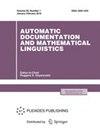应用图论研究JSM推理结果
IF 0.5
Q4 COMPUTER SCIENCE, INFORMATION SYSTEMS
AUTOMATIC DOCUMENTATION AND MATHEMATICAL LINGUISTICS
Pub Date : 2023-11-24
DOI:10.3103/S0005105523050023
引用次数: 0
摘要
通过JSM推理得到的数据进行处理。我们构造对象图和假设图。它们的结合点分离的对象没有共同的可能原因观察到的影响,以及这些影响的可能原因。此外,图的双连通成分可以更方便地对数据进行分组,以供进一步研究。本文章由计算机程序翻译,如有差异,请以英文原文为准。

Applying Graph Theory to Study the Results of JSM Reasoning
Data obtained as a result of JSM reasoning is processed. We construct graphs of objects and graphs of hypotheses. Their articulation points separate objects without common possible causes of observed effects, as well as the possible causes of these effects. In addition, the biconnected components of graphs make it possible to group data in a more convenient way for further study.
求助全文
通过发布文献求助,成功后即可免费获取论文全文。
去求助
来源期刊

AUTOMATIC DOCUMENTATION AND MATHEMATICAL LINGUISTICS
COMPUTER SCIENCE, INFORMATION SYSTEMS-
自引率
40.00%
发文量
18
期刊介绍:
Automatic Documentation and Mathematical Linguistics is an international peer reviewed journal that covers all aspects of automation of information processes and systems, as well as algorithms and methods for automatic language analysis. Emphasis is on the practical applications of new technologies and techniques for information analysis and processing.
 求助内容:
求助内容: 应助结果提醒方式:
应助结果提醒方式:


